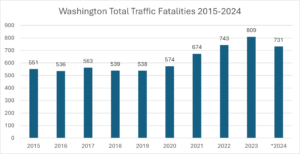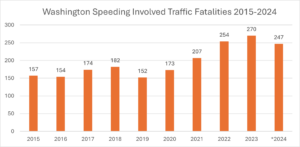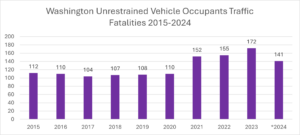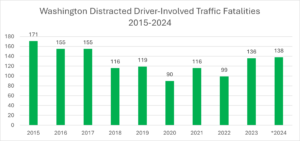Preliminary Traffic Fatality Numbers for 2024 Decrease from 33-Year High in 2023
OLYMPIA, Wash. – There were 731 people killed in traffic crashes on Washington roads in 2024, which was an 9.6 percent decrease from the prior year, according to preliminary data released by the Washington Traffic Safety Commission.[1] At the same time, the preliminary total for 2024 is 36 percent higher than the number of people killed on Washington roads in 2019.
Traffic enforcement efforts have increased statewide, resulting in larger numbers of traffic stops for speeding, distraction, and suspected driver impairment. Enforcement fell dramatically during and immediately following the COVID-19 pandemic. Some cities have also increased their use of automated enforcement for speeding, particularly in school zones and in other areas where pedestrians travel.
A number of policies have been put in place in recent years to address the recent traffic safety crisis. Washington may be starting to see benefits from these actions in reduced fatalities on Washington roads.
“This is obviously a welcome change to see our annual fatality numbers decline after experiencing large increases over the previous four years. Law enforcement and other traffic safety partners have worked hard to reverse the deadly trend we experienced in 2020-2023. And we still have a lot of work to do to further reduce these historically high fatality numbers,” said Shelly Baldwin, director of the Washington Traffic Safety Commission.
Driver impairment by alcohol and/or other drugs remains the most common risk factor involved in fatal crashes. The initial total involving impaired driving was 348 traffic deaths, which represents 48 percent of all fatalities. This number often rises as additional evidence is processed and recorded in these cases. Final numbers will be released in late 2025 or early 2026.
Speed remains another major factor in fatal crashes, as excessive speed increases both the likelihood and severity of a crash. In 2024, 247 people were killed in crashes involving excessive speed, which represented 34 percent of all fatalities. There is a substantial overlap in crashes involving both speed and impaired driving. Among fatalities involving excessive speed, 62 percent also involved an impaired driver.
Motorcyclist fatalities saw a substantial decline, by nearly 20 percent, to 113 fatalities in 2024. Notably, these fatalities involving a speeding motorcyclist fell nearly 21 percent.
Another particular bright spot was the decline in fatalities of people who were not wearing seat belts or using child passenger restraints. Fatalities involving unrestrained vehicle occupants fell 18 percent in 2024, compared to 2023.
A record number of pedestrians were killed in 2023. These numbers appear to have declined only slightly in 2024 to 155, compared to 160 pedestrians who were killed in 2023. Pedestrians, bicyclists, and motorcyclists are all more vulnerable in crashes with motor vehicles.
Distracted driver-involved fatalities increased in both 2023 and 2024, involving 136 and 138 deaths, respectively. This is a concerning change as these numbers had previously fallen to 90 in 2020, after Washington passed a distracted driving law in 2017. However, distracted driver-related fatalities are still fewer than the state experienced prior to the law change.
Through its Target Zero efforts, the state is also focusing attention on land use planning and traffic designs which help ensure that people who walk, roll, and use transit have safe places to travel wherever they need to go. WSDOT and local jurisdictions are increasingly using roundabouts, which dramatically lower the number of fatal crashes at these intersections, and other engineering measures which calm vehicle speeds, increase visibility and separate road users in time and space.
“The bottom line is that four driver behaviors contribute to at least 75 percent of traffic fatalities annually: impaired driving, speeding, distracted driving, and failure to wear seat belts,” said Mark McKechnie, WTSC external relations director. “In order to make our roads safer, we should drive sober, at safe speeds, without distractions, and buckle up. And we should encourage those we care about to do the same.”
For additional data and ten-year trends, you can view our data dashboards at https://wtsc.wa.gov/dashboards/.
[1] All 2024 data included here and percentages related for 2024 are preliminary and subject to change as additional information is collected and analyzed during 2025.




